Archive for the ‘Business Network’ Category
OCO No Mo’
Tuesday, February 24th, 2009 
NASA’s Taurus launch of the Orbiting Carbon Observatory did no go well last night. Lost it:
NASA’s Orbiting Carbon Observatory satellite failed to reach orbit after its 4:55 a.m. EST liftoff Feb. 24 from California’s Vandenberg Air Force Base.
Preliminary indications are that the fairing on the Taurus XL launch vehicle failed to separate. The fairing is a clamshell structure that encapsulates the satellite as it travels through the atmosphere.
The spacecraft did not reach orbit and likely landed in the ocean near Antarctica, said John Brunschwyler, the program manager for the Taurus XL.
Bummer. Here’s the launch video:
Commercial Launches from Florida
Friday, October 24th, 2008
That’s the live view from Cape Canaveral’s Launch Complex 39, where the Space Shuttle will launch from in November.
Meanwhile, lots of activity at Launch Complex 36 this week, too. The U.S. Air Force announced it will soon host civil and commercial payload launches:
Officials with the Air Force and Space Florida made history during a dedication ceremony held here Oct. 22 when Space Launch Complex 36 officially was made available for operational use by the State of Florida, subject to completion of the environmental impact analysis.
Attending the historic ceremony were Florida Governor Charlie Crist; Florida Lt. Governor Jeff Kottkamp; Space Florida President Steve Kohler; Lt. Gen. William Shelton, 14th Air Force commander; and Brig. Gen. Susan Helms, 45th Space Wing commander.
General Shelton said Air Force leaders supported the initiative because it will make it easier for commercial providers to launch from the U.S. Having domestic launch options provides the U.S. with solid foundation for national security.
"This is a great partnership that is mutually beneficial to both the Air Force and the state," he said. "We take great pride in helping foster the success of the commercial space sector; I’m confident the spirit of innovation and the cooperation that made this a reality will continue in the years ahead."
Governor Crist also had positive things to say about the agreement.
"Florida has always been home to big ideas. The entrepreneurial spirit is woven into the DNA of Florida’s economy," the governor said. "And thanks to the Air Force’s decision, the door is now open to innovation and space opportunities never seen before. In tough economic times, it is important we do not sit idly by, but that we invest in economic opportunities for the future.
"What a tremendous opportunity to ensure that space exploration is a top priority and that the U.S. remains a leader right here from Florida," he said.
According to Space Florida officials, the reconfiguration of Launch Complex 36 will strengthen not only the state’s aerospace industry but other growing economic sectors such as biotechnology and environmentally friendly energy technology vital to Florida’s future. The launch complex will support light- to medium-lift vehicles that go into low-Earth orbit and beyond.
Space Florida’s president sees this ground-breaking ceremony as a great beginning, both literally and figuratively.
"The Air Force assignment of Launch Complex 36 is an important next step to extending access to space," said Steve Kohler, Space Florida president.
"We are now making that available to both defense and security initiatives," he said, "with multiple commercial payloads and launch activities for both civil and private space businesses that want to launch from Florida. This direction by the Air Force, together with the tremendous support by the state, opens the door to attracting, supporting and sustaining national and international aerospace business here in Florida."
This effort also is in line with the mission of the 45th SW, according to General Helms.
"Our primary mission here is to assure access to the high frontier," she said. "This proposal better enables us to execute that mission. It’s the ultimate ‘win-win’ situation for both the Air Force and the State of Florida."

Hours later, PlanetSpace announced it is ready to start, spurring Florida Today to report it will generate 350 jobs and a $300 million economic impact:
PlanetSpace, a consortium of ATK, Lockheed Martin and Boeing, announced Wednesday a proposal to launch a 158-foot solid-fuel rocket by 2011 from the pad at Cape Canaveral, which the Air Force has agreed to lease to Space Florida. The rocket could carry about 2 metric tons of cargo to the International Space Station.
NASA aims to announce on Dec. 23 whether PlanetSpace, or a competitor, has been chosen to provide the service. The company says its plan would create 350 jobs in Florida, with a potential economic impact of $300 million. PlanetSpace said it has at least two competitors for the NASA award.
Using state money, Space Florida now will start turning the abandoned launch complex into a serviceable launch pad, which it hopes will attract other commercial customers.
"The door is now open to more innovation," said Gov. Charlie Crist, who spoke Wednesday at the groundbreaking of the launch complex upgrade.
Complex 36 is now just a domed bunker beside a concrete slab at Cape Canaveral. The Air Force, which controls the property, intends to lease the site to Space Florida after an environmental impact analysis.
Space Florida, a state economic development agency focused on aerospace projects, then would build a launch facility that could accommodate medium to light rockets. The state plans a commercial launch zone that would reduce bureaucratic requirements and eliminate tariffs, similar to a free trade zone.
"This is a rebirth of a historical launch complex," Space Florida President Steve Kohler said.
Kohler said he is negotiating with several launch companies that may use the pad. The state has appropriated $14.5 million for the project and has bonding authority for another $40 million.
"We hope that the first phase of development could reach $55 million to build it out," Kohler said.
PlanetSpace hopes to be the first to use the new site in 2011. Under NASA’s Commercial Resupply Services program, the group is competing for a $3.1 billion government contract to move 20 metric tons of cargo to the space station with 10 to 12 rocket launches.
We see which bidder will be celebrating on 23 December 2008, with a great big contract under the tree (Solicitation Number: NNJ08ZBG001L).

Send In The Rocket Scientist
Wednesday, October 8th, 2008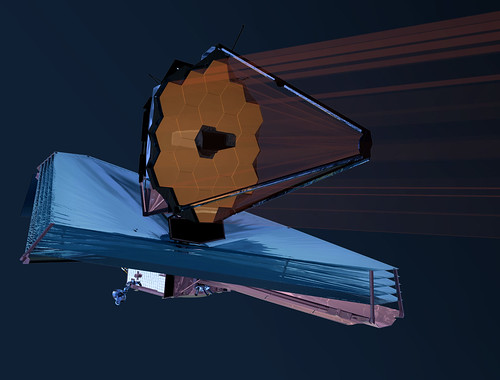
Watched the U.S. presidential debate last night and neither could explain their position on this $700 billion bailout/rescue. Seems their economic talking points haven’t changed much in six months (Main Street, middle class, tax the rich). We need Madison Avenue to start selling these leading candidates.
Now we’ve got an interesting angle, as far as we’re concerned and way to go, NPR! They called it before we did in today’s Morning Edition piece on Neel Kashkari, the new Interim Assistant-secretary for Financial Stability: "Ex-Rocket Scientist To Oversee Financial Bailout." He worked on NASA’s Jame Webb Space Telescope at TRW. Click here to listen:
Back in the 1990s, Tom Dautel worked on a team led by Kashkari to design a solar car called the Photon Torpedo at the University of Illinois. He says Kashkari worked like a slave, often even on projects he wasn’t directly overseeing.
"He meant business. He wanted to get the job done. He was very focused, and it doesn’t surprise me he ended up where he is," Dautel says.
Poorni Bid says Kashkari’s intensity made the man she and other classmates called Rocket Scientist seem wise and competent beyond his years.
"He stood out in just his focus and just his intensity," she says. "And you’d think everyone in MBA school would be like that, but there was a different quality about him."
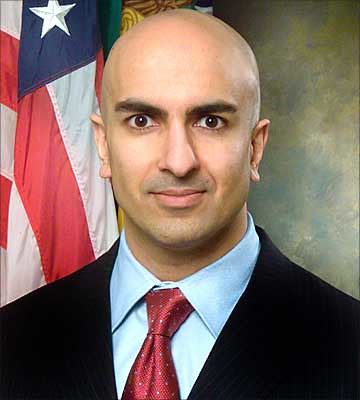
The Independent (U.K.) gives us some background:
Before he became one of the "masters of the universe", as the ambitious bankers of Wall Street are known, Mr Kashkari was headed towards becoming a master of the cosmos, doing important work for Nasa’s space program. Banking is not in his blood. Science is. His father, Chapman, is a retired professor of engineering, and his mother Sheila is a pathologist. It was to science that the young Neel Kashkari originally hewed, taking a bachelor’s and a master’s in engineering at the University of Illinois at Urbana-Champaign, his home state’s flagship public university. His first major career was as a research and development investigator at a company called TRW in Redondo Beach, California, which had an illustrious history as a contractor to Nasa, creating several of its deep space satellites. At TRW, Mr Kashkari helped develop technology for new space science missions such as the James Webb Space Telescope, which is due for launch in 2013 as a successor to the ageing Hubble telescope and which will go searching for light from the first stars formed after the Big Bang.
The sheer complexity of this situation will take a rocket scientist to fix, but it’s already affecting the presidential race:
Within the poll numbers, Obama appears to have been helped by a number of factors. For one, voters generally tend to say they believe Democrats are better at handling the economy than Republicans, and that appears to have happened here. A new Hotline poll shows that over the last week the percentage of respondents who feel McCain is better prepared than Obama to handle the economy fell five percentage points, from 43 to 38 percent.
McCain’s personal performance, from his attempt to cancel the initial presidential debate to his silence in presidential meetings on the bailout, did not gain him new votes, at least in the short term. A USA Today/Gallup poll taken before the bailout failed to pass the House on Monday showed that 53 percent of respondents judged his actions unfavorably.

Tasting The Ice Plumes of Enceladus
Wednesday, August 13th, 2008
Planetary scientist Carolyn Porco is very happy this week, judging from her blog post on recent Cassini-Huygens images:
Well, folks, the images are down … at last!! … and I can’t print here what I first said upon seeing them. What a dazzling success! There doesn’t even appear to be any smear. Paul Helfenstein (imaging team associate who planned the images), you genius … here’s one big hug from me, man! We here at CICLOPS are all giddy, even moved to tears.
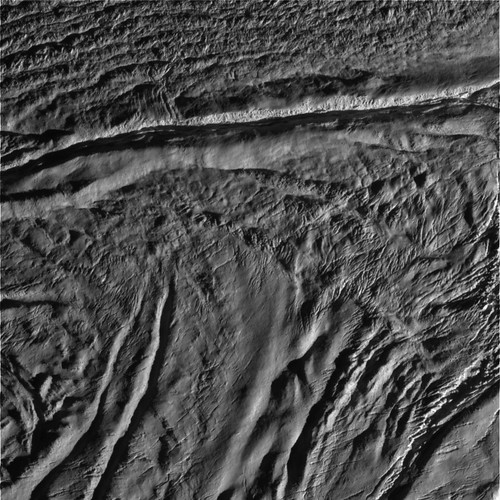
The ice plumes of the Saturn moon were first seen last October. Here’s an animated rendering:
This week’s mission is noteworthy, as they’ve practically brushed by the surface:
During closest approach, Cassini successfully passed only 50 kilometers (30 miles) from the surface of the tiny moon.
Cassini’s signal was picked up by the Deep Space Network station in Canberra, Australia, and relayed to the Cassini mission control at NASA’s Jet Propulsion Laboratory in Pasadena, Calif.
"We are happy to report that Cassini’s begun sending data home," said Julie Webster, Cassini team chief at JPL. "The downlink will continue through the night and into tomorrow morning."
Closest approach occurred at approximately 3:21 p.m. PDT, while Cassini was traveling at a swift 17.7 kilometers per second (40,000 miles per hour) relative to Enceladus.
During the flyby, Cassini focused its cameras and other remote sensing instruments on Enceladus with an emphasis on the moon’s south pole where parallel stripes or fissures dubbed "tiger stripes" line the region. That area is of particular interest because geysers of water-ice and vapor jet out of the fissures and supply material to Saturn’s E-ring. Scientists hope to learn more about the fissures and whether liquid water is indeed the engine powering the geysers.
You’ll enjoy this video:
Predicting Space Weather
Monday, July 21st, 2008On reading that title, you might be asking yourself “why in the world would I need to predict space weather?” Well, I’ll tell you. Space weather – the range of high-energy radiation, such as X-rays and gamma rays, that constantly bombard the Earth’s atmosphere – affects the performance of some of your favorite gadgets, like GPS and satellite TV.

With this camera, scientists can predict changes is space weather, allowing for communications companies to compensate for electromagnetic interruptions to their signals. Never again will your Planet of the Apes marathon be spoiled by a bad signal. Oh, and it’ll help the military predict and plan for interruptions in their communications too.

The project – the Global-Scale Observations of the Limb and Disk – is known by a catchy acronym: GOLD.
The GOLD Camera will fly on an SES AMERICOM satellite. Physicist Richard Eastes, who leads the GOLD project, says this is the first time that a NASA instrument has flown on a commercial communications satellite.
This is the second “hosted” payload for an AMERICOM spacecraft just this month. The other was for the Air Force’s CHIRP (Commercially Hosted Infrared Payload).
Russian Hide-N-Seek
Wednesday, July 16th, 2008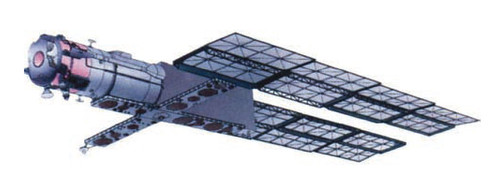
As Mark Twain said, "Always tell the truth. That way, you don’t have to remember what you said." The Russian Defence Ministry’s Information and Public Relations Directorate ought to make a note of it.
Back in April, Red Orbit reported they denied a major satellite malfunction:
"In connection with reports published in some mass media alleging that the Kosmos-2421 satellite has disintegrated, we would like to report that its planned flight programme has been fulfilled. After switching off its on-board equipment, the satellite was taken out of service in accordance with the established procedure", reads the directorate’s report received by Interfax-AVN today.
According to the Defence Ministry, "the Kosmos-2421 satellite remains in its orbit, the parameters of which correspond to the predicted ones, and is under steady observation by means of the national system of space control".
The ministry added that there are three more space objects in orbits close to Kosmos-2421. "One of them is a stage vehicle of a carrier rocket, and the other two – fragments of a launch [vehicle]", the report says. [Passage omitted on "a NASA website" report on the alleged disintegration of the satellite; background]
Originally published by Interfax-AVN military news agency website, Moscow, in Russian 1431 15 Apr 08.
Well, according to NASA’s Orbital Debris Quarterly News, that’s not entirely true:
Late in the first quarter of 2008, the U.S. Space Surveillance Network (SSN) detected a significant fragmentation of Cosmos 2421 (International Designator 2006-026A, U.S. Satellite Number 29247), which produced approximately 300 detectable debris (see ODQN, Vol. 12, Issue 2). Two more fragmentation events of the same spacecraft during April-June added another 200 or more large debris (greater than 5 cm) to the near-Earth space environment, once again raising questions about the peculiar nature of this satellite class.
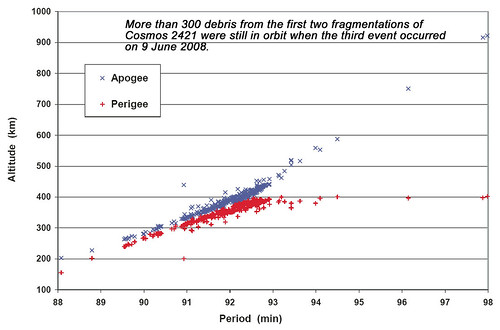
You can count on our friends at U.S. Strategic Command’s Space Surveillance Network to keep an eye on them.
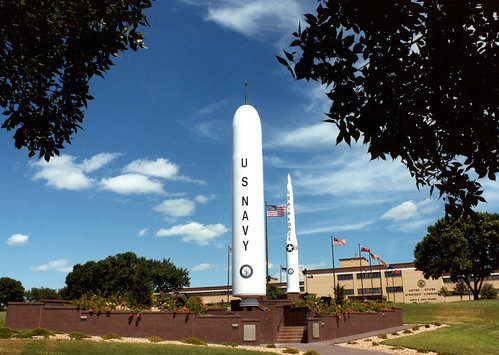
First Storm of the Season
Monday, July 7th, 2008 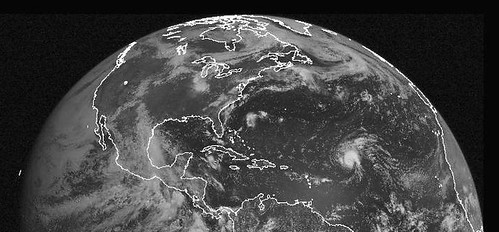
It’s officially hurricane season and Bertha is gearing up to be the year’s first storm.
Whether you might find yourself in the eye of the storm or you’re just intrigued by extreme weather, you’re sure to appreciate the fun tools that the National Weather Service puts out for the public. This one lets you track the storm’s movements. And this one shows wind speeds.
How do they get all the data for these cool images? Why satellites, of course. And the NOAA has a full arsenal. But how does all the information coming from those satellites turn into something we can understand, like this animation of the season’s first hurricane?
With Giovanni it’s simple. And no, that isn’t the name of an Italian tropical storm guru…
Giovanni is actually an acronym for the GES-DISC (Goddard Earth Sciences Data and Information Services Center) Interactive Online Visualization ANd aNalysis Infrastructure.
In other words, it’s a web-based application developed by NASA that is available to anyone with a computer and a bit of spare time. But beware, for those of us who’ve lost hours tooling around on Google Earth, this can become a bit addictive…
DIY Friday: Sky Show
Friday, July 4th, 2008No, not your own fireworks — playing with chemistry at home is dangerous. We’re talking dazzling astronomic observation, as this "image of the day" from NASA:
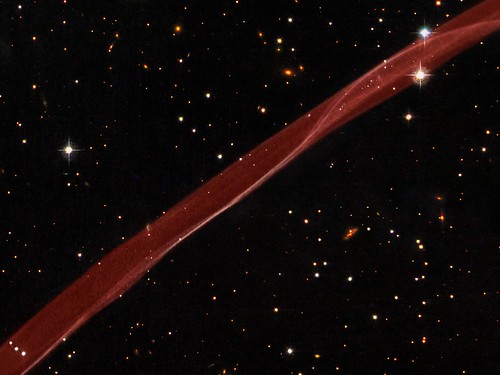
Stars and a Stripe in Celestial Fireworks
A delicate ribbon of gas floats eerily in our galaxy. A contrail from an alien spaceship? A jet from a black-hole? Actually this image, taken by NASA’s Hubble Space Telescope, is a very thin section of a supernova remnant caused by a stellar explosion that occurred more than 1,000 years ago.
Around May 1, 1006 A.D., observers from Africa to Europe to the Far East witnessed and recorded the arrival of light from what is now called SN 1006, a tremendous supernova explosion caused by the final death throes of a white dwarf star nearly 7,000 light-years away. The supernova was probably the brightest star ever seen by humans, and surpassed Venus as the brightest object in the night time sky, only to be surpassed by the moon. It was visible even during the day for weeks, and remained visible to the naked eye for at least two and a half years before fading away.
It wasn’t until the mid-1960s that radio astronomers first detected a nearly circular ring of material at the recorded position of the supernova. The ring was almost 30 arcminutes across, the same angular diameter as the full moon. The size of the remnant implied that the blast wave from the supernova had expanded at nearly 20 million miles per hour over the nearly 1,000 years since the explosion occurred.
Today, SN 1006 has a diameter of nearly 60 light-years, and it is still expanding at roughly 6 million miles per hour. Even at this tremendous speed, however, it takes observations typically separated by years to see significant outward motion of the shock wave against the grid of background stars. In the Hubble image as displayed, the supernova would have occurred far off the lower right corner of the image, and the motion would be toward the upper left.
Image Credit: NASA, ESA, and the Hubble Heritage Team (STScI/AURA)

But NASA is predicting a planetary alignment for today and this weekend, via PhysOrg.com:
The show gets going on Friday, July 4th. Red Mars and ringed Saturn converge just to the left of the bright star Regulus. The three lights make a pretty 1st-magnitude line in the heavens.
But that is just the beginning. On Saturday, July 5th, with weekend fireworks at fever pitch, a lovely crescent Moon joins the show. Saturn, Mars, and the Moon trace an even brighter line than the night before.
Scan a small telescope along the line. You’ll see Saturn’s rings, the little red disk of Mars, a grand sweep of lunar mountains and craters, and just maybe—flash!—a manmade incendiary. How often do you see fireworks through a telescope?
This is, however, more than just a flashy gathering of planets—it is also a gathering of spaceships and robots.
Each of the three worlds is orbited or inhabited by probes from Earth. Saturn has the Cassini spacecraft, studying the gas giant’s storms, moons and rings. The Moon has two probes in orbit: Kaguya from Japan and Chang’e-1 from China. The pair, operating independently, are mapping the Moon and scanning for resources in advance of future human landings. NASA’s Lunar Reconnaissance Orbiter will join them later this year.
Mars has more probes than the others combined. Three active satellites orbit the red planet: Europe’s Mars Express and NASA’s Mars Odyssey and Mars Reconnaissance Orbiter. The three not only study Mars with their own instruments, but also form a satellite network in support of NASA’s Mars rovers Spirit and Opportunity and Mars lander Phoenix.
None of these mechanical specks are visible in a backyard telescope, but they are there, heralds of a growing human presence in the solar system. Tell that to your buddy at the fireworks show!
During the short night of July 5th, the Moon glides past Mars and Saturn so that nightfall on Sunday, July 6th, brings a different arrangement—a scalene triangle. The triad is easy to find in the hours after sunset. Look west and let the Moon be your guide.
In the nights that follow, the Moon exits stage left, leaving the others behind. Don’t stop watching, though. Saturn and Mars are converging for their closest encounter of the next 14 years. After nightfall on Thursday, July 10th, the two planets will be just ¾ of a degree apart, snug enough to fit behind the tip of your pinky finger held at arm’s length.
Now that’s spectacular—no fireworks required.
Cool. No smoke, fire or noise. There’s more than enough of that going on around you. To all the rocket scientist in the U.S., have a great 4th of July.
Phoenix: Day Two on Mars
Tuesday, May 27th, 2008The big news of the holiday weekend was, of course, the successful landing of the Phoenix Mars Lander at 7:53 pm Eastern time on Sunday — a landing which we previewed two weeks ago.

There was only one minor snag reported in the challenging landing: the protective sheath around the trench-digging robotic arm failed to unwrap all the way after touchdown. The sheath now covers the arm’s elbow joint, but NASA describes that as merely an "inconvenience."
The excitement behind the successful landing was evident. Maybe it was because of the slow holiday weekend, but the landing was big news in the mainstream media — not just among space buffs– with the Drudge Report parking a headline most of the day on Sunday and Monday that asked if Phoenix would find evidence of life on Mars as it explored the planet’s arctic plain.
Since the trench-digging arm that Phoenix will use to collect the soil samples that might contain traces of organic compounds won’t be extended until possibly tomorrow, the answer to the Drudge Report’s questions is clearly "not yet."
But already, Phoenix has sent back some amazing pictures and videos of the Red Planet’s polar region:
- The Mars Reconnaissance Orbiter snapped this dramatic photo of the Phoenix Lander suspended beneath its parachute as it descended to Mars on Sunday. (For an explanation of how the Orbiter snapped the photo, watch this video.)
- Here’s a good video from inside the Jet Propulsion Laboratory as Phoenix touched down, showing the excitement and anxiety inside mission control.
- Check out this photo of where Phoenix landed (in the Vastitas Borealis region) as well as this animation showing an orbital view sweeping upward from Olympus Mons, the tallest volcano in the solar system, to the flat terrain where Phoenix touched down.
- A bevy of raw images from the Red Planet (in black and white) are available here.
- How do the images and video come back to earth? NASA explains.
- More videos and animations of Phoenix are available here.
All in all, NASA has outdone itself in providing information to the public over the web for the Phoenix mission — and done an incredible job of packing that information in a compelling way.
The next press briefing on the mission is set for 1 pm Eastern today. Also check out the Phoenix Landing blog for more updates.